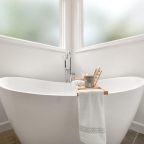
Can Shower Panels Be Installed Over Existing Tiles?
Bathroom renovation can be pretty costly in terms of time and money. Most people would immediately be drawn to the convenience and the aesthetics that shower panels provide in any renovation of the shower area. These sleek, modern alternatives to traditional tile not only make the bathroom look great but offer ease of cleaning and water-resistant surfaces.
However, one common question that pops up is whether shower panels can be put directly over existing tiles. The notion may be pretty appealing; you would not have to go through the labor and expense of trying to remove old tiles from the wall.
The following article will review the pros and cons of installing shower panels over tile, guide the necessary preparation, and help you determine if this is a viable option for your bathroom renovation.
Is It Possible to Install Shower Panels Over Tile?
Well, the basic answer for most projects will be yes; one can directly install shower panels over existing tiles. But when it comes to certain caveats, there is more.
The critical factor is how well the existing tile has been maintained. The shower panels are designed to be mounted on a smooth, even surface, and if the tile is in good condition, it can work well for the panels.
On the other hand, if it is damaged, loose, or uneven, it does not offer a solid base. Installation over unstable tile may result in future problems in shower panels, such as looseness, cracks, and even leaks.
Another problem has something to do with the thickness of how thick the tile currently goes. Most shower panels run about 1/4", and anything thicker will almost ultimately create a problem by possibly mounting an improper working surface-one that might give poor closure after that.

Preparing the Tile Surface
If you plan to install shower panels over an existing tile, proper surface preparation is vital. This involves:
- Inspect the Tile: Carefully inspect the existing tile to determine its condition. Note each of the loose, broken, or uneven tiles in areas that will need exceptional work.
- Cleaning the surface: The tile should be cleaned with a degreaser in order to remove soap scum and grime, or whatever else might be on it. In this way, it will be clean and dry for proper adhesion of the panel adhesive.
- Repair the broken tile: If you notice a few loose or cracked tiles, they will have to be fixed or replaced before any panels can be installed; any problem areas should be set in with thin-set mortar or tile adhesive.
- Level uneven surfaces: In case the tile has high spots or low points, you may have to use a floor leveling compound for a smooth, even surface. This will ensure that panels can be installed flush against the wall.
- Priming the tile: Apply tile bonding primer or liquid membrane on the cleaned and repaired tile surface. This shall create the correct bonding for the panel adhesive.
All the preparation steps should be done carefully to successfully install shower panels over the tile. These critical steps must be completed to maintain the integrity and longevity of the finished project.

Tips for Successful Installation
If you decide to go ahead and install shower panels over existing tile, here are some tips to help ensure a successful installation:
- Selection of appropriate panel system: Every shower panel system needs to be more suitable to be installed above the tile. Look out for those that are advertised as suitable explicitly for such an application, typically featuring a thinner profile along with unique adhesives/sealants.
- Surface preparation: Proper surface preparation is paramount, as discussed earlier. Ensure thorough inspection, cleaning, repair, and leveling of the existing tile to achieve an ideal base.
- Using the right adhesive: This is a significant input, as is the adhesive used to bond these panels onto the tile. Panel adhesive is available that is formulated for proper bonding to tile and standard material. The panels are fabricated from acrylic and PVC.
- Sealing off the edges and seams: It is necessary to make watertight seals on all perimeters and panel seams. Finish off with a quality flexible silicone sealant for areas meant to come into contact with wet surfaces.
- Follow the manufacturer's instructions: Every shower panel system has specific installation guidelines provided by the maker. Follow the instructions as given in the literature, and be sure to do things right so that the installation can last for a longer period.
- Consider future maintenance: While installing over tile saves time and money now, future maintenance or panel replacement can become quite a problem. Consider your long-term plans for the bathroom.
So, heeding these tips and paying close attention to thorough surface preparation of the tile is perhaps the best way to improve success with a shower panel installation over an existing tile. It's an important decision that one weighs after considering all the pros and cons based on an individual situation.
Wrapping Up
Installing shower panels over existing tiles can be viable and convenient for many bathroom renovations. As long as the underlying tile is in good condition and adequately prepared, the panels can provide a sleek, modern update without needing complete tile removal.
However, it's crucial to consider the potential drawbacks, such as limitations on thickness, increased weight load, and future maintenance challenges. Thoroughly evaluating your specific situation and following best practices for installation will be key to ensuring a successful, long-lasting result.
Ultimately, installing shower panels over tile will depend on your bathroom layout, construction, and personal preferences. With the proper preparation and attention to detail, this can be a cost-effective and visually appealing solution for upgrading your shower space.

















